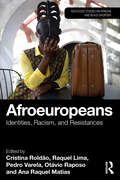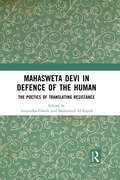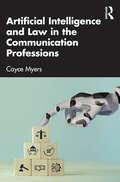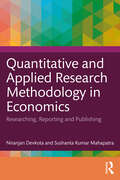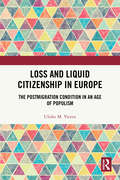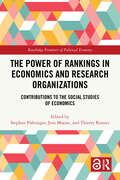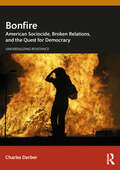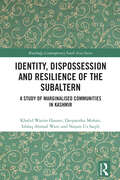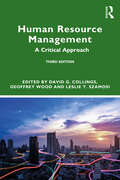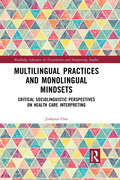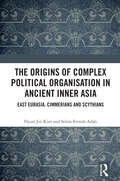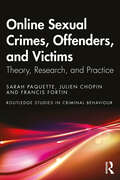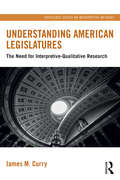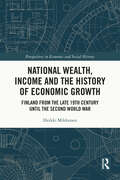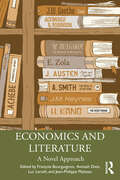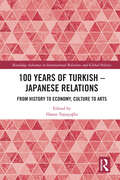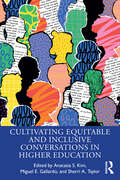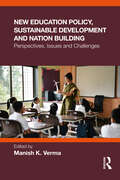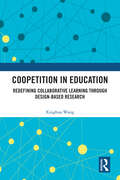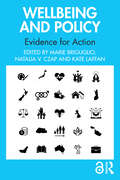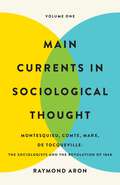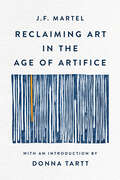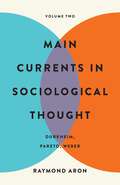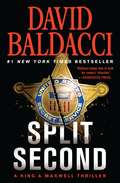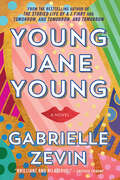- Table View
- List View
Afroeuropeans: Identities, Racism, and Resistances (Routledge Studies on African and Black Diaspora)
by Cristina Roldão Raquel Lima Pedro Varela Otávio Raposo Ana Raquel MatiasAfroeuropeans: Identities, Racism, and Resistances reflects on the tensions, ambiguities, and paradoxes of Blackness in Europe.The book addresses relations of domination and modes of racial exclusion, but also Afro-European interventions in the political, social, cultural, and artistic spheres, and the multiple resistances that have sustained Black bodies in the European continent. At the same time as Black histories, cultures, and social conditions are made invisible in hegemonic accounts in Europe, there is a hypervisibility and presence of Black stereotyping in European popular culture. Black identities have become even more conditioned by new mainstream far-right discourses and the tightening immigrant and refugee policies that affect people of African descent. One of the book’s most innovative contributions is the attention it gives to Black South European thought, experiences, and resistance—particularly in the Portuguese context. This constitutes not only a critique Europe’s pervasive racism and "color blindness" policies but also makes a significant contribution to a broader understanding of Blackness and racism, extending beyond the U.S. and Northern European contexts.This book is forged in a moment of particularly strong Black intellectual and political vitality. Given the book’s intersectional and transdisciplinary approach, it will be an important go-to for students and researchers across the humanities and social sciences, as well as to artists, activists, politicians, and journalists.
Mahasweta Devi in Defence of the Human: The Poetics of Translating Resistance
by Anuradha GhoshThis book re-thinks the literary and social worlds of Mahasweta Devi, the prolific and influential writer and social activist, in connection to her praxis. It brings into focus Devi’s preoccupation with the human, nature and life, and unwritten or distorted histories that underline her poetics of translating resistance in terms of a radical alterity.The defining feature of Devi’s writings is the position she adopts in defence of the human, questioning the nature of the ‘abject’ in her discourse on the oppressed. Essays in this volume focus on her subversive retellings from the Mahabharata, the political aspects of translation/adaptation of her works in literature, cinema and visual arts and comparative readings of her works by women authors from the Global South as well as the Indian diaspora. They examine her early publications, her writings for children, and the notion of aesthet(h)ics, i.e., ethics and/in aesthetics, as a gesture to pave forward a discourse on liberation and social justice that remains a challenge for the world.The book will be of significant interest to scholars and researchers of postcolonial and decolonial studies, critical translation and adaptation studies, comparative literature, the visual arts, myth and folklore studies, gender and sexuality studies, caste and ethnicity studies, culture studies, ethics in/and aesthetics, activism studies, democratic and indigenous rights discourse, South Asian studies and Global South studies.
Artificial Intelligence and Law in the Communication Professions
by Cayce MyersThis book analyzes the current attempts to regulate artificial intelligence (AI) and its impact on the communication field.Examining existing and proposed laws, policies, and regulations of AI in the U.S. and the European Union, this book analyzes how the technological development of AI will be governed in the next decade and how this will impact the communication industry. Chapters explore the influence of laws on key communication issues including free speech, disinformation, intellectual property, privacy, and discrimination, as well as the AI industry’s approach to self-regulation. It shows how communication professionals such as public relations practitioners, advertisers, and journalists will be affected by generative AI content production and how communication will ultimately be shaped by the regulations and laws placed on AI.Providing readers with a working knowledge of the contemporary legal issues surrounding AI and communication, this book will be of interest to scholars and students in the fields of Media and Communication Law, Public Relations, Advertising, and Journalism.
Quantitative and Applied Research Methodology in Economics: Researching, Reporting and Publishing
by Sushanta Kumar Mahapatra Niranjan DevkotaThis book is an illustrative and comprehensive guide designed to help readers understand and navigate the complex world of academic writing and research in economics.Written by experienced researchers, this book offers theoretical and practical insights into the research process. It provides an understanding of the foundations of the research process like research design, methodology, problem definition, data collection, and analysis, among others. The authors also share insights into the process of preparing, proofreading, and publishing academic papers. With their experience in the field of academic research to this book, they provide practical examples and step-by-step guidance to assist in research-related issues. The section on how to prepare and publish academic papers is a must-read for students and early-career researchers, as it offers valuable guidance on how to succeed in the highly competitive world of academic publishing.With its clear and concise writing, this book will be an indispensable resource for undergraduate and postgraduate economics students, teachers, independent readers, and early-career researchers as well as those seeking a deeper understanding of research methodology in economics.
Loss and Liquid Citizenship in Europe: The Postmigration Condition in an Age of Populism
by Ulrike M. VietenLoss and Liquid Citizenship in Europe offers a means of understanding how experiences of loss intersect with discourses of migration and citizenship, to affect feelings of belonging with respect to host communities and newcomers. Adopting a de-colonial and intersectional perspective, it examines the condition of postmigration, regarding it as a space of social, cultural, and political transformation. In doing so, it questions the dominant binary in terms of both legal distinctions and socio-cultural distinctions between settled majorities and migrating minorities. Confronted with the spread of a neo-populist, far-right political agenda across the world, this book provides new insights into ways in which we might re-conceptualise a vision of social inclusion for both majorities and minorities on the move. As such, it will appeal to scholars and students across the social sciences with interests in migration and diaspora, citizenship and belonging.
The Power of Rankings in Economics and Research Organizations: Contributions to the Social Studies of Economics (Routledge Frontiers of Political Economy)
by Stephan Pühringer Jens Maesse Thierry RossierDiscourses around research excellence and quality are predominant within the economic sciences, with various forms of ranking playing a central role. They make “excellence” in research and teaching visible, but they also create hierarchical orders between researchers, institutions, publication outlets and countries.The authors of this volume analyse the role of rankings in shaping and transforming economics from different theoretical, methodological and disciplinary perspectives. The various contributions explore the specific situation in different countries as well as global developments within economics and beyond. In addition, the book contributes to an overall debate about the role and function of rankings in academia. The analysis focuses on four aspects: rankings and social hierarchies, rankings and paradigmatic hegemonies, rankings and regulations/policies, as well as rankings and critique/alternatives.The book addresses scholars in economic sociology, economics, higher education and science studies.
Bonfire: American Sociocide, Broken Relations, and the Quest for Democracy (Universalizing Resistance)
by Charles DerberCharles Derber shows how the US is moving toward sociocide – the erosion of durable, positive social relations in the economy, family, politics, and civil society essential to sustaining society itself – while offering pragmatic solutions.Bonfire: American Sociocide, Broken Relations, and the Quest for Democracy examines how new technologies and financial strategies are part of broader economic, environment, cultural, and political shifts that create tipping points generating more competition, distrust, isolation, and violence. In doing so, Derber spells out the implications for democracy and social cohesion. Importantly, he explores options that could stop the spiral and reconstruct a sustainable and equitable community, civil society, and democracy via emerging movements against neoliberalism capitalism, climate change, war – and in favor of labor solidarity, human rights, and community.This book will be of interest to students, scholars and activists with an interest in political sociology, political economy, and social movements in the US.
Identity, Dispossession and Resilience of the Subaltern: A Study of Marginalised Communities in Kashmir (Routledge Contemporary South Asia Series)
by Deepanshu Mohan Khalid Wasim Hassan Ishfaq Ahmad Wani Najam Us SaqibKhalid Wasim Hassan, Deepanshu Mohan, Ishfaq Ahmad Wani and Najam Us Saqib examine the processes of marginality and ‘othering’ which the subaltern groups in Kashmir face due to their attribution to a particular social caste, ethnicity, language or status of their citizenship. They further explore the sense of belonging and identity formation of the Pashtun community in the Kashmir Valley, India.The book provides a balanced discussion on theoretical debates and empirical cases, with the introductory chapter providing an overview of the theoretical framework on identity and dispossession and its relationship to the processes of marginalisation. The other chapters discuss specific empirical cases that provide the theoretical underpinnings on relevant notions, such as caste, ethnicity, nationalism and identity politics. Through the empirical cases of the Sheikh community and Hanji community, the book sheds light on the prevailing caste system and caste-induced discrimination among Muslims. It also further explores the different forms of resilience as exercised by the subaltern groups in Kashmir, where many social groups and communities experience marginalisation and how some communities such as Tibetan Kashmiri Muslim, which lacked the state-defined citizenship status till recently, had led to the exclusion of this community from various socio-economic and political rights.This is a comprehensive volume that will appeal to academics, scholars and policymakers in South Asian studies, social sciences and humanities, especially those interested in the study of caste, ethnicity, nationalism and identity politics for the marginalised communities in Kashmir.
Human Resource Management: A Critical Approach
by David G. Collings, Geoffrey Wood and Leslie T. SzamosiWritten by an international team of respected scholars, Human Resource Management: A Critical Approach, 3rd edition, adopts a critical perspective to examine the core management function of human resource management (HRM) in all its complexity – including its darker sides. Despite over three decades of debate around the nature of HRM, its intellectual boundaries and its application in practice, the field continues to be dogged by several theoretical and practical limitations. This textbook opens with a critique of the very concept of HRM, tracing its development over time, and then systematically analyses the context of HRM, practice of HRM and international perspectives on HRM.New chapters commissioned for this third edition examine HRM and consider issues including diversity and inclusion, employee well-being, digitalisation and AI, sustainable HRM and gig work and job deconstruction.This textbook is essential reading for advanced and inquisitive students of HRM, and for HRM professionals seeking to deepen their understanding of the complexities of their field.
Multilingual Practices and Monolingual Mindsets: Critical Sociolinguistic Perspectives on Health Care Interpreting (Routledge Advances in Translation and Interpreting Studies)
by Jinhyun ChoFocusing on health care interpreting in Australia, this book examines the under-recognition of interpreting from a critical sociolinguistic perspective encompassing language, race and class.Interpreters play an important role in promoting diversity and inclusion but why is interpreting not properly recognised? Cho grapples with this question by focusing readers’ attention to developments in interpreting following increased migration in an English-monolingual Australia, a context in which other languages and speakers have been historically under-valued. Through compelling analysis and the voices of health care interpreters in Australia, this groundbreaking book explores how issues with interpreting are fundamentally issues of justice that affect minority languages and their speakers. Covering diverse professional and social spaces of interpreting, the book discovers linguistic, racial and class hierarchies embedded in English monolingualism and their impact on multilingual practices and populations. From both historical and contemporary perspectives, the book critically investigates monolingual practices from the past and tensions between enduring monolingual ideologies and multilingual realities, suggesting specific ways to overcome monolingual mindsets to make societies more inclusive.This volume will be of interest to students and scholars in interpreting studies, health communication, intercultural communication and sociolinguistics.
The Origins of Complex Political Organisation in Ancient Inner Asia: East Eurasia, Cimmerians and Scythians
by Hyun Jin Kim Selim Ferruh AdalıThis book explores the origins of complex political organisation in Inner Asia, which enabled mighty empires, proto-state entities and confederacies such as the Cimmerians, Scythians and the Xiongnu Huns to emerge and dominate large swathes of the Eurasian continent during antiquity.The volume provides readers with an in-depth understanding of the origins and development of the quasi-feudal system of political organisation, which prevailed in Inner Asia during antiquity, how this supported the formation of imperial polities in the steppe zone, and the impact the expansion of these polities had on the politics, history and culture of both ancient Inner Asia and also China, the Middle East and Europe. It examines the historical and archaeological evidence for the Cimmerians and Scythians and their geopolitical impact on western Eurasia, exploring whether the complex political organisation in Inner Asia – which we see later among the Xiongnu and the Huns – originated with them or had even earlier antecedents.The Origins of Complex Political Organisation in Ancient Inner Asia is suitable for students and scholars of Near Eastern history and archaeology, the history and archaeology of Central and Inner Asia, and classical antiquity.
Online Sexual Crimes, Offenders, and Victims: Theory, Research, and Practice (Routledge Studies in Criminal Behaviour)
by Julien Chopin Sarah Paquette Francis FortinAdopting a multidisciplinary perspective, this volume explores contemporary knowledge regarding the online sexual exploitation of children and adolescents, and challenges prevailing myths perpetuated by society and the media concerning this form of violence, the offenders, and their victims.Drawing on a wealth of data collected from real cases in Quebec, the book introduces readers to explanatory models of online offending and victimization, the criminal trajectories and characteristics of online offenses, the individual attributes of offenders and victims, issues pertaining to virtual identities and anonymity preservation techniques, and considerations for prevention and intervention practices.Online Sexual Crimes, Offenders, and Victims will be of interest to students, researchers, and professionals in the fields of criminal justice and public health, including criminologists, psychologists, psychiatrists, psychotherapists, social workers, police investigators, probation officers, magistrates, and lawyers.
Understanding American Legislatures: The Need for Interpretive-Qualitative Research (Routledge Series on Interpretive Methods)
by James M. CurryIn this passionately argued book, James M. Curry introduces legislative scholars to the value and importance of interpretive research. His field guide for getting started on using an interpretive approach is designed so that the reader can understand a new methodological approach, not just new methods or “tools” within a singular approach.Weaving in his own story from student to scholar, Curry begins by demystifying the importance and value of interpretive research. He later provides background on what interpretive methodologies are and how they differ from the quantitative and positivist approaches that dominate the field. Focusing primarily on the study of the US Congress and the 50 American state legislatures, Curry employs Richard Fenno’s “soaking and poking” language as a bridge to the language of interpretivism, aiming to show legislative researchers how they can connect between the two and begin to use the richer terms of the latter in place of the former.Understanding American Legislatures is a must-read contribution to the study of legislatures and our discourse about methods in American politics.
National Wealth, Income and the History of Economic Growth: Finland from the Late 19th Century until the Second World War (Perspectives in Economic and Social History)
by Heikki MikkonenDespite its current dominant status, economic growth emerged as a field of study and as a political objective only after the Second World War. This book provides an alternative perspective to the Anglo-centric historical analysis of growth by turning the focus on Finland and other Nordic countries from the late 19th century until the Second World War. Moreover, it provides a conceptual history perspective to how economic growth can be examined before the emergence of economic growth as a concept.This book places Finland in the context of emerging nation-states of the early 20th-century Europe and constructs five competing growth conceptions: classical liberal, agrarian conservative, social liberal, social democratic, and communist. With a methodology derived from conceptual history, this book presents a framework to study economic growth in the context of nationalism. It showcases how ideas related to growth have not been synonymous with capitalism, but rather they have been connected to state-building and to comparison of economic systems. The findings of the book highlight the interwar period as a key turning point in historical analysis of growth.This book provides a fresh and a thought-provoking account that will be of interest to students and scholars of economic history, history of ideas, development studies and degrowth, and history of capitalism.
Economics and Literature: A Novel Approach
by François Bourguignon Luc Leruth Avinash Dixit Jean-Philippe PlatteauEconomics and fiction often pursue parallel objectives. Economists analyze human decisions and interactions in markets and other institutions. Fiction writers also provide keen insights into individual minds and motives, examining how their characters respond to conflict and tensions in varied situations. This book explores the insights to be gained from developing this parallel.In each chapter, economists discuss classic or contemporary literary creations, exploring economic incentives that motivate the characters, the economic mechanisms that tie them together, and/or the economic context in which they live and develop. Exploring the synergy across economics and literature offers new understandings of themes, including capitalism and colonialism, marriage and markets, gender norms, inheritance and estates, and the political economy of poverty. The broad and deep range of literary works includes writers from Shakespeare and Goethe, through Chekov and Steinbeck, to recent Nobelists Abdulrazak Gurnah and Han Kang. By offering new understandings of both economics and literature, readers will gain deeper insights into people’s thought processes, choices, and consequences.This book will captivate readers in economics, social sciences, and the humanities and open their minds to the viewing of economic ideas and concepts through the prism of great works of literature.
100 Years of Turkish-Japanese Relations: From History to Economy, Culture to Art (Routledge Advances in International Relations and Global Politics)
by Hasan TopaçoğluJapan and Türkiye, situated at opposite ends of Asia like two pillars of a bridge, have long maintained strong relations. These ties, spanning over a century, encompass historical, cultural, political, and social dimensions. Topaçoğlu and his contributors present a comprehensive analysis of Asia that deepens our understanding of the complex interplay between these two nations in the global arena.Structured into three segments, the first explores the historical backdrop, carefully examining the evolution of relations between Japan and Türkiye while analysing their outreach to the West and Asian nations throughout history. The second examines various themes encompassing international relations, political science, and economics that critically examine the historical trajectory leading up to the present, shedding light on the evolving dynamics with other Asian nations. The final segment centers on media and cultural studies, education, literature, and the arts that provide detailed insights into Türkiye’s evolving engagement with other Asian countries. The book offers fresh perspectives and novel methodologies that challenge conventional paradigms by adopting an inclusive approach. Through a comparative lens, it illuminates the evolving contours of Japan–Turkish relations amidst shifting geopolitical landscapes. Furthermore, it serves as a catalyst for future research endeavours, paving the way for deeper insights into the historical, diplomatic, and socio-cultural dimensions of these nations.A valuable resource for scholars and researchers in the fields of international relations, political science, history, cultural studies, and Asian studies in the context of Japan and Türkiye. The book will also be of interest to professionals involved in policy formulation and diplomatic practice, policymakers at governmental institutions, diplomats, and strategy consultants who are engaged in advising on international relations or geopolitical strategy as well as journalists, think-tank analysts, and the informed public who are keen on understanding the complexities of global geopolitics and both countries' evolving roles within it.
Cultivating Equitable and Inclusive Conversations in Higher Education
by Sherri A. Taylor Miguel E. Gallardo Anatasia S. KimThis book is a practical guide for educators seeking to facilitate diversity, equity, and inclusion (DEI) conversations in higher education. More than ever, students expect their learning to address the pressing challenges in our world today. Against the backdrop of growing social justice movements, cancel culture, and deepening polarization, faculty and administrators require effective skills to navigate the strong opinions and emotions that arise when addressing social issues in the classroom and on campus. Authors in this timely volume unpack why DEI conversations are difficult, highlight common missteps when facilitating such conversations, and offer readers practical skills that support robust, inclusive, and meaningful discussions. Featuring real-world examples from educators on the front lines, this book provides actionable tools and practices to cultivate learning environments that foster student engagement, deep learning, inclusion, and a sense of belonging.
New Education Policy, Sustainable Development and Nation Building: Perspectives, Issues and Challenges
by Manish K. VermaThe book provides a comprehensive account of the linkages between education, sustainable development, and nation-building from an interdisciplinary perspective. It examines various theories of education and sustainable development and critically explores the origin, evolution, and contours of education in India through the lens of the current policy debates around the Indian educational system. The book also investigates to what extent the New Educational Policy deliberations can be instrumental for the nation’s development, as well as be an effective tool for devising sustainable solutions, including the new challenges posed by climate change.An important blueprint of higher education policy and planning, the book will be indispensable for teachers, students, and researchers of education, public policy, educational studies, development studies, sustainable development, sociology, history, and political studies. It will also be of immense interest to policymakers, development practitioners, and NGOs.
Coopetition in Education: Redefining Collaborative Learning through Design-Based Research
by Xinghua WangThe book explores the development of coopetition designs aimed at enhancing student collaborative learning, addressing persistent challenges such as low individual accountability and the associated free-rider issue.Moving beyond the long-standing and inconclusive debates between collaboration and competition, the book embraces the concept of coopetition—a hybrid approach that merges the strengths of both collaboration and competition while mitigating their respective weaknesses. The author develops two initial coopetition designs: social-comparison coopetition and zero-sum coopetition, both of which underwent rigorous examination and refinement through three iterative research cycles, followed by the design-based research methodology. He reveals that social-comparison coopetition consistently outperformed other designs across all cycles, demonstrating enhanced student motivation, engagement, and self-regulated learning. By contrast, while zero-sum coopetition showed slight advantages in one-off applications, its repeated use required careful handling. In conclusion, the book introduces two key design principles that define the core components and appropriate contexts for implementing coopetition, with a particular emphasis on social-comparison coopetition.The book will be valuable for researchers, educators, and teachers looking for new theories and strategies to enhance collaborative learning.
Wellbeing and Policy: Evidence for Action
by Marie Briguglio Kate Laffan Natalia V. CzapAs wellbeing becomes an increasingly explicit policy goal in countries across the world, the demand for evidence upon which to base intervention is growing. Featuring 41 contributing authors from 18 countries, this book surveys and synthesizes recent developments in wellbeing science and policy to highlight key lessons learned and to offer actionable insights for policy-making.Opening with a foreword by Roberta Metsola, President of the European Parliament, and an introductory chapter surveying the fundamentals of wellbeing policy, the book reviews the links between wellbeing and various domains, including income, work, health, family, altruism and empathy, ageing, gender, education, housing, environment, crime, democracy, migration, religion, digital technology, and art, culture, and creativity. The book also examines the state of the art on wellbeing policy frameworks in diverse contexts, including developed and developing countries, small and large states, across the world, documenting interventions by governmental, private, or non-governmental organizations. Case studies include Bhutan, New Zealand, Finland, the United Arab Emirates, Canada, Australia, the United Kingdom, Japan, and Malta.This book is essential reading for anyone interested in progressing towards a wellbeing economy including policy-makers, academics, and students in economics, public policy, public administration, and behavioural and political science.
Main Currents in Sociological Thought: Montesquieu, Comte, Marx, De Tocqueville: The Sociologists and the Revolution of 1848
by Raymond AronThe first volume of the landmark study, tracing the emergence and formation of sociological thought from the French liberal school to the Marxists Main Currents in Sociological Thought remains a foundational synthesis in the field. In this first part of his magisterial two-volume survey, Raymond Aron embraces an expansive definition of sociology that merges empirical inquiry with historical and social analysis. At its core, Aron&’s work is an engagement with the very question of modernity: How did the intellectual currents that emerged in the eighteenth century shape the modern political and philosophical order? With scrupulous fairness, Aron examines the thoughts and arguments of the discipline&’s major social thinkers to discern how they answered this question. Volume 1 explores three traditions: the French liberal school of political sociology, represented by Montesquieu and Tocqueville; the Comtean tradition, anticipating Durkheim in its elevation of social unity and consensus; and the Marxists, who posited the struggle between classes and placed their faith in historical necessity. Written with his customary lucid elegance of thought and style, Aron&’s work is essential reading for students across the social sciences.
Reclaiming Art in the Age of Artifice
by J.F. MartelA compelling call to rediscover the transformative power of art in an age of distraction, coercion, and spectacle – featuring an introduction from Pulitzer Prize–winning author Donna Tartt In Reclaiming Art in the Age of Artifice, J. F. Martel offers a compelling and incisive meditation on the nature of art in a world dominated by invasive media, rampant consumer culture, and artificial intelligence. Drawing on a wide range of examples, from Paleolithic cave art to contemporary cinema, Martel argues that true art reveals the unseen forces shaping our existence—forces that transcend politics, technology, and even culture. In contrast to artifice, which seeks to manipulate or distract, authentic art calls us back to the essence of things, opening &“rifts&” onto the sublime and the weird and reconnecting us with the radical mystery at the heart of the world. Featuring an introduction by Pulitzer Prize–winning author Donna Tartt, this edition also includes a new afterword by the author, reflecting on the continued relevance of art in our increasingly mediated world.
Main Currents in Sociological Thought: Durkheim, Pareto, Weber
by Raymond AronThe second volume of the landmark study, examining the work of sociology&’s defining thinkers from the turn of the nineteenth century to the interwar periodMain Currents in Sociological Thought remains a foundational synthesis in the field. In this second and final volume of his classic survey, Raymond Aron explores the work of three figures who profoundly shaped sociology as it entered the twentieth century: Durkheim, who continued Comte&’s quest for a science of society and a scientific validation of morality; Pareto, the Italian &“neo-Machiavellian&” who emphasized the elitist character of all societies; and Weber, the German sociologist who reflected critically on the prospects for human freedom in an age of disenchantment. Bringing together penetrating intellectual portraits of these great thinkers and close readings of their most consequential texts, Main Currents in Sociological Thought highlights the historical and intellectual context within which each man wrote and draws out their works&’ enduring insights and influence in the field today.
Split Second (King & Maxwell Series #1)
by David BaldacciTwo Secret Service agents sworn to guard their protectees lost them in a single moment . . . and in this #1 New York Times bestseller, they're about to learn that the violence has just begun.Michelle Maxwell has just wrecked her promising career at the Secret Service. Against her instincts, she let a presidential candidate out of her sight for the briefest moment and the man whose safety was her responsibility vanished into thin air.Sean King knows how the younger agent feels. Eight years earlier, the hard-charging Secret Service agent allowed his attention to be diverted for a split second. And the candidate he was protecting was gunned down before his eyes. Now Michelle and Sean are about to see their destinies converge.Drawn into a maze of lies, secrets, and deadly coincidences, the two discredited agents uncover a shocking truth: that the separate acts of violence that shattered their lives were really a long time in the making—and are a long way from over.
Young Jane Young: A Novel
by Gabrielle ZevinFROM THE NEW YORK TIMES BESTSELLING AUTHOR OF TOMORROW, AND TOMORROW, AND TOMORROW AND THE STORIED LIFE OF A. J. FIKRY&“SLY, EXHILARATING . . . HILARIOUS.&” —People (Book of the Week)"BRILLIANT AND HILARIOUS." —Chicago Tribune This is the story of five women . . . Meet Rachel Grossman. She&’ll stop at nothing to protect her daughter, Aviva, even if it ends up costing her everything. Meet Jane Young. She&’s disrupting a quiet life with her daughter, Ruby, to seek political office for the first time. Meet Ruby Young. She thinks her mom has a secret. She&’s right. Meet Embeth Levin. She&’s made a career of cleaning up her congressman husband&’s messes. Meet Aviva Grossman. The Internet won&’t let her or anyone else forget her past transgressions. This is the story of five women . . . . . . and the sex scandal that binds them together. From Gabrielle Zevin, the bestselling author of The Storied Life of A. J. Fikry, comes another story with unforgettable characters that is particularly suited to the times we live in now . . .
